The Architecture of Occupation: A Tool for Erasing Palestinian Identity
The recent episode of Al Jazeera's program, Architecture of the Occupation, delves into the intricate ways in which Israel exploits architecture and urban planning to assert control over Palestinian territories. Through eight detailed chapters, the program explores critical themes such as the apartheid wall, land ownership laws, and the impact of settlements on Palestinian communities. Host Mona Hawa challenges the dominant narratives surrounding these issues, revealing a systematic approach to erasing Palestinian identity and heritage.
Exploiting Nature: The Role of Pine Trees in the Occupation
One of the striking revelations from the episode is how the Israeli occupation utilizes nature, specifically through the planting of pine trees, as a means of control. Architect Eyal Weizman elucidates that these trees acidify the soil, inhibiting the growth of native grasses essential for traditional Palestinian herding practices. This ecological manipulation serves to undermine the Palestinian economy and lifestyle, demonstrating how environmental factors are weaponized in the broader context of occupation.
A Comprehensive Strategy of Control
The episode further highlights the multifaceted strategies employed by Israel to alter the geographical and demographic landscape of Palestine. From the construction of the apartheid wall to the systematic demolition of Palestinian homes, these actions are part of a deliberate effort to reshape the identity of the region. Additionally, the program discusses the controversial renaming of Palestinian sites to Hebrew names, a practice that aims to erase historical and cultural connections to the land. Overall, the episode calls for increased awareness and documentation of these architectural practices as essential components of the struggle for Palestinian rights and identity.





